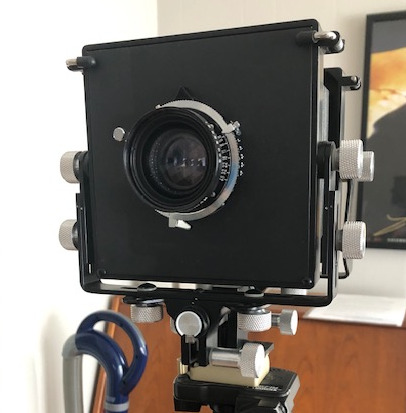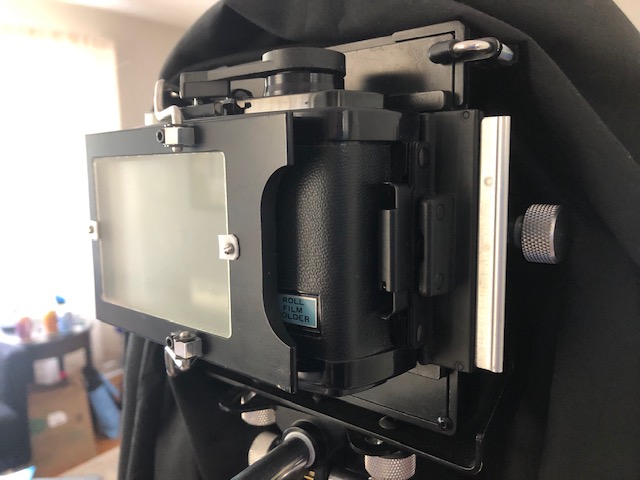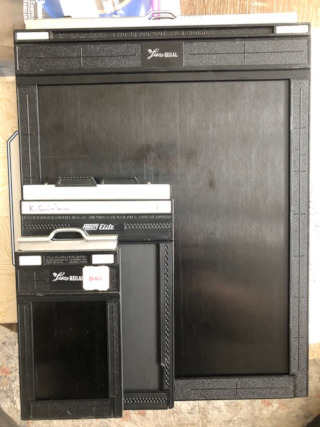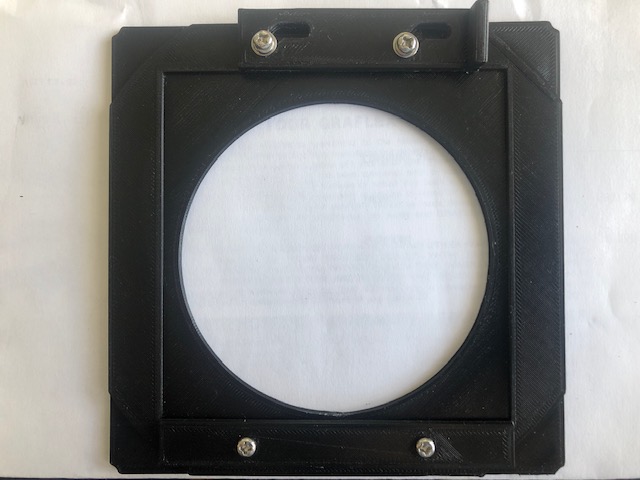Cameras
Galvin 2x3
Introduction
The late Jim Galvin produced a relatively small number of hand built cameras in 2x3 (6x9) and 4x5 formats. The one these notes are based on has a serial of 1159 (it is stamped on the bottom of the tripod mount - not a common location). I also know of one serial number 2095 dating from at least 1982. The 4x5 cameras all seem to have numbers above 1000 as well, so it may be that the two designs shared a common number range. I would not be surprised to find the total production of the two designs combined was less than 2,000. The 2x3 is one of a fairly small set of small format view cameras produced by a few manufacturers using 2 1/4 x 3 1/4 sheet or 8 frames on 120 roll film.

It is a fairly classic design, though with some limitations due to the small size of the format. The 4x5 has a larger rear standard, tapered bellows and a longer rail, but the capabilities are otherwise very similar.
Design and Construction
The camera is a conventional monorail design with rise/fall, swing, shift, and tilt at the front, and a limited set of tilt and swing at the rear. Movements are limited compared to larger format cameras, being a few 10’s of millimeters, but enough for landscape and general work. Architectural subjects would likely need more options.
The back is a ground glass and bail design. The back can be removed and rotated, but the bail mechanism is fixed. The bail mechanism handles conventional double sided film holders (very small if one is used to 4x5 or 8x10 holders) and holds the Graflex/Horseman roll film backs easily.
The monorail has a geared brass track on the bottom which is used by the rear standard mounting for focusing. The rack also acts as the ‘key’ to stop the rail mounts from rotating. The front standard is a clamp and slide mounting, as is the tripod mount. Teflon sleeves are used in place of lubricant, and these can wear and need replacement. It is possible to swap the lens panel and the camera back to get the most movements at the film end, and with focusing at the front. However, the back standard has angled arms to allow easy horzontal changing of film holders or roll film backs. Swapping the standards may limit the use of back tilt. Still, the camera does offer the option.
The camera was offered with two bellows lengths, 9 inches and 14 inches. The 14 inch version came with a two part (5 inch and 9 inch) rail, while a 9 inch rail was used for the shorter version. This makes the 9 inch version a double extension, and the 14 inch model a triple extension based on the format standard. For the longer (14 inch) bellows version, either rail section may be used, or both combined. The 5 inch rail makes for compact storage, but is too short for general use. The 9 inch bellows is really limited to 150mm lenses with close-up ability, and is probably less desirable.
Published Movements
Taken from the camera data sheet. Short lenses, or those with large rear elements, may be bellows limited. Swing and tilt are given in degrees.
| Standard | Rise | Fall | Swing | Tilt | Shift Left | Shift Right |
|---|---|---|---|---|---|---|
| Front | 18mm | 12mm | 30 | 30 | 18mm | 18mm |
| Rear | - | - | 30 | 30 | - | - |
Film Options
There are a small number of 2.25 x 3.25 sheet film options available in monochrome. Ilford do FP4+ and HP5+ in 25 sheet boxes, but it is usually special order. Adox CHS II is another option at ISO 100, and there are the Arista EDU Pro 100 and 400 emulsions. Cutting down 4x5 to two smaller sheets is an option. At the time of writing, FP4+ in 2.25 x 3.25 was about the same price as 4x5 for 25 sheets. Since cutting down gives access to the whole range of 4x5 emulsions, it may be worth considering the effort for the cost and flexibility.
For colour film, the choice is essentially limited to cutting down 4x5.
Film in 120 format requires an RH-8 roll film holder for the closest equivalent of 6x9. The later lever advance ones with pin rollers adjacent to the pressure plate seem to give the best results with current film. There are 6x7 and 6x6 options too, but anything larger, such as 6x12, cannot be accommodated by the rear opening. Horseman and Mamiya RB (those with film advance interlocks to the camera body may need alteration) holders intended for this format should also work.

The RH-8 roll film back inserted under the ground glass. The film advance release is just visible between the ground glass frame and the lever advance on the roll film holder. The back mounting can also be seen. It consists of two domed screws at the bottom that the panel slips behind, and two sprung rotating clamps at the top. Both the back and the lens board use the same fitting. There are small cutouts in the corners to accommodate the screws. Interestingly, on this example the back seems to be set for vertical or right side insertion as the rear frame only has cutouts on the right and top.

As an indication of the film format of this camera, here are examples of 2.25x3.25, 4x5, and 8x10 film holders.
6x9 versus 2.25 x 3.25
They are not quite the same. The sheet is a touch smaller than the roll film frame, so a 6x9 roll film glassless carrier will allow a sheet to fall through.
Roll film can be processed by any suitable tank with a 120 format spiral. The 2.25 x 3.25 sheets are too small for the Jobo 2509 reel at the smallest setting (6x9), and reels set for 120 format are not suitable. So either an old sheet processing tank, some custom design, or tray developing will be required for sheet film.
Lens Choice
The camera has options for 5" (125mm), 9" (228mm) or 14" (355mm) rails. The 5" makes for a compact camera for transport, but is too short for normal and long lenses. The bellows are just long enough at the longer length, and place a minimum for the short focal lengths - full compressed the 14 inch model bellows place the shutter some 75mm from the film plane. OK for a pinhole, but a 75mm or shorter lens demands a recessed board. So in practice the range for the 14 inch bellows is around 75mm to 240mm, or maybe 270mm, though recessed or top-hat boards may be needed below 75mm and above 240mm for reasonable movements and close focus. The lens boards are unique to this camera, but are fairly easy to fabricate.
At the moment my lens options are the 135mm Symmar-S that is dedicated to it, the 90mm Caltar II (on a recessed Wista/Linhof board in my 4x5 kit), the 210mm Sironar (4x5/8x10), and maybe the 270mm G-Claron from my 4x5/8x10 set. A 75mm would be a nice addition.
The usual standard for the format is 105mm, though 90 to 135mm could be used. If a 75mm is used as the wide, normal is between 100mm and 135mm, then the long could be 210mm to 270mm. Recessed boards are desirable with 75mm and below, and practically essential with 65mm if any movement is desired.

This is a fully 3D printed Wista/Technika adapter. The M3 screws seat into heat set sockets. This board has been configured so that it can be seated in any of the four orientations to allow offset Wista boards to be positioned as best suits the desired Rise/Fall/Shift. The design is done in OpenSCAD, and also includes the option to do centered and offset plain Galvin boards.
First Thoughts
After using a 4x5, the ground glass feels like a postage stamp! A good loupe is practically essential, especially when using movements or stopping down. But the finish is nice, and the camera looks the part. It is obvious that the camera is hand built, because the tolerances are not as tight as they could be. This is not a Linhof.
My large format experience has been with technical or wood field camera designs. This camera is not much different, as the movements are smaller and fewer than a 4x5 monorail. Indeed my wooden Wista DX has rear shift in addition to tilt and swing.
It would be nice to have an accessory shoe on one of both standards. As it stands there is no facility for levels, gadgets, etc. that are shoe fitting.
It is reasonably light and compact (weights to nearest gram).
| Item | Wista | Galvin |
|---|---|---|
| Weight, body | 1902g | 1268g |
| Weight, lens | 261g | 320g |
| Weight, 4 holders | 726g | 420g |
| Weight, roll back | 646g | 388g |
| Total | 3535g | 2396g |
This puts the Galvin kit about 68% of the weight of the Wista. This does not include dark cloths, bags, meters, filters, tripod, etc. 2,396g is about 5.25lbs.
Notes:
Wista DX, wood with rear shift/tilt/swing, double extension (12"/300mm) bellows. Lens Rodenstock Sironar 150mm. Holders 4x5. Rollfilm holder Calumet C2 (6x9).
Galvin 2x3, rear tilt/swing, triple extension (14 inch model). Lens Schneider-Kreutznacht Symmar-S 135mm. Film holders 2.25x3.25. Roll film holder Graflex RH-8 (6x9).
The Galvin 2x3 Compared to a Wood 4x5
The obvious comparison is to a 4x5 camera with a 6x9 back. The 4x5 is somewhat larger, though a wood field 4x5 camera is not much different from the metal Galvin. There are practical minimums due to the size of clamping knobs, mounts, and thickness of parts, so the Galvin is not a lot less weight than a wood 4x5.
Where the 4x5 will score is:
- the option to use 4x5 film,
- wide range of sheet and roll-fim development options
- a longer bellows (potentially - the Wista is double extension while the Galvin is triple extension,
- bigger image,
- movements may be larger or more extensive,
- and a better range of optics.
Where the Galvin scores is:
- film holders are smaller and lighter, though sheet development options are fewer,
- roll film holders are essentially the same size as the sheets, so no format debate,
- more compact when considered as a set of camera, holders,
- the aperture inside the front standard is fairly large, so an offset adapter plate could be used to increase shift/rise/fall or re-center a tilted lens with limited coverage.
Given equal technique, a 4x5 negative should enlarge more than 2.25x3.25 or 6x9 for a given print quality. But for smaller prints, say 11x14 or smaller, the difference may not be significant.
The 6x9 ground glass is small when judging movements, so a good loupe is essential.
Using 4x5 Film Holders
It is possible to use 4x5 film holders via an adapter - see the Galvin 23 4x5 Film Adapter page. This allows an image area of 90x90mm on a 4x5 sheet.
References
There is not much online. Most of this is secondary sources:
-
Toyo TV23G and Galvin 2x3: a comparative review. Goggin, Jeffrey, Large Format Photography Forum.
-
Graflex RH-8 roll film back manual. There are some interesting points, notably about the correct lubrication in the Maintenance section on Page 5.
RH-8 Manual Page 1, RH-8 Manual Page 2, RH-8 Manual Page 3, RH-8 Manual Page 4
RH-8 Manual Page 5, RH-8 Manual Page 6, RH-8 Manual Page 7, RH-8 Manual Page 8
-
Running a search for ‘Galvin’ on Photrio.com turns up a lot of anecdotes.